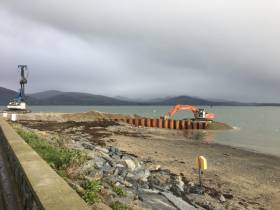Displaying items by tag: GreenoreGreencastle
#SeaTrials - A car ferry that is set to launch the new year-round Carlingford Lough ferry service has been conducting sea-trials between the Cooley and Mourne Mountains, writes Jehan Ashmore.
According to the ferry owners, the Frazer Ferries Group, a master from the Passage East Ferry Co (acquired by the group last year) has been assisting the captains of car ferry Frazer Aisling Gabrielle during sea-trials on Carlingford Lough.
The operation trading as Scenic Carlingford Ferry will serve between Greenore, Co. Louth and Greencastle, Co. Down. The new route will transform the relationships of both regions by opening up new tourist potential.
The 44 car-capacity Frazer Aisling Gabrielle can take cars, coaches and holiday-homes along with motorbikes, however Scenic Carlingford Ferry have stated in recent days that due to circumstances beyond their control, passengers will not be hosted on board this week.
When crossings begin, times will vary between 15 to 20 minutes and this depends on tidal and wind conditions. The new link will give a minimum saving of 40 minutes on any point to point journey.
For the last decade there have been plans to establish a service. The project that has seen an investment of €9.75 million (£8.5 million) was entirely funded by the Group that has a registered office in Limerick.
The Group took over the Lough Foyle service along with acquiring Foyle Venture for €1 million in late 2015. The 300 passenger ferry resumed service the following year linking Magilligan Point, Derry and Greencastle, Donegal, however the route for this season is closed. The summer service was heavily dependent on its core business of Northern holidaymakers headed to Inishowen Peninsula and the rest of Donegal.
Foyle Venture however this Spring deputised for the Passage East-Ballyhack ferry, F.B.D. Tintern during dry-docking at the New Ross Boatyard. Following such work, it was the turn of the former Foyle ferry. The UK custom-built vessel dating to 1978 was launched as Shannon Willow. She originally served Shannon Ferries which is controlled by other interests.
In order to prepare the almost 50m long ferry for service on Carlingford, €1m was spent on the refit that led to newly installed engines, hydraulics, ramps and other engineering works. The facility at New Ross on the banks of the Barrow also involved applying a new livery to reflect the Carlingford service. This saw the car ferry emerge as the Frazer Aisling Gabrielle and also make an overnight en-route call to Wicklow Port last month.
There will be three crews and SCF will employ 15 people full time, with additional seasonal employment during the peak season.
New Route: Ferry On Carlingford Lough To Sail This Year
#NewRoute - A ferry service which has been long awaited between Greenore and Greencastle, linking both sides of Carlingford Lough, will launch early this summer, writes the Argus.
'Construction work has commenced and we're planning to have the ferry service operational by the early part of the summer,' said Paul O'Sullivan of Carlingford Lough Ferries.
The project, which is estimated to have the potential to create 300 jobs directly and indirectly, was first mooted a decade ago but faced numerous delays due to objections, particularly on the northern side.
'It has taken eight or nine years to get to this point in time but we had two jurisdictions to deal with, so we had to double up on everything - planning applications, marine licences, environmental studies, as well as dealing with two sets of statutory bodies,' said Mr O'Sullivan.
To read more the newspaper has a report here.





























































